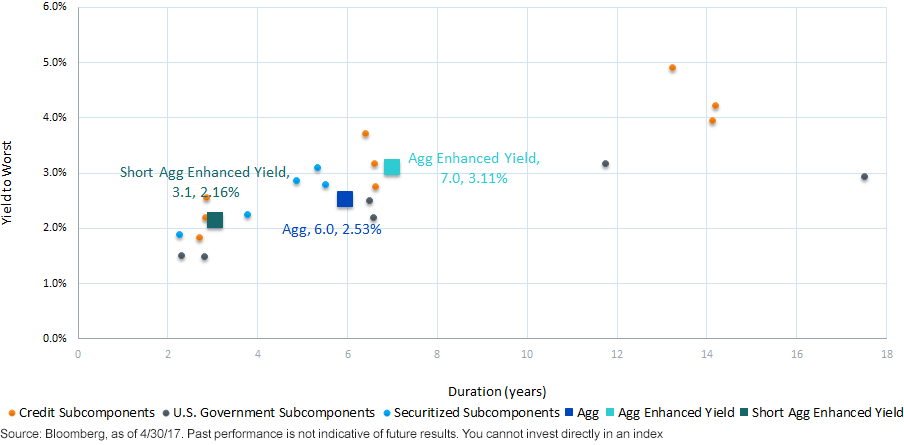2017 Update: Enhance Your Aggregate Positions While Reducing Risk


After hiking rates in March 2017, the Federal Reserve (Fed) remains poised to increase interest rates two additional times this year, we believe. Despite this consensus view, nominal interest rates are lower than they were to start the year at maturities of five years or greater.1 Below, we highlight the likely driver of what we believe will prove to be a temporary decline in rates. In response, we believe investors should consider adding credit risk to their core bond portfolio while at the same time reducing interest rate risk.
Year-to-Date Decline in Rates
While shifts in global markets seldom have a singular catalyst, we believe a significant contributor to the move lower in rates has been a result of the repricing in confidence of the Trump administration’s ability to affect pro-growth polices with Congress. In our 2017 outlook, our 3.00% rate target for U.S. 10-year debt was predicated on the passage of pro-growth fiscal policies combined with a meaningful infrastructure spending bill. Any potential distractions from this agenda will likely continue to increase uncertainty and keep rates at more subdued levels. We believe it is no coincidence that rates peaked in early March after Trump issued his controversial “travel ban” executive order. In our view, this setback represents an annoying distraction in Trump’s policy agenda, not necessarily a retrenchment. As such, we would continue to advocate that investors tactically shift to a position under-weight in duration in advance of any potential shift in the political winds of Washington.
Add Risk Worth Taking, Subtract Risk That’s Not
While many investors may find themselves uncomfortably long in equity and credit markets, we do not currently forecast a marked deterioration in credit quality for the majority of U.S. investment-grade (IG) companies. In response, while credit currently may provide less value than when we initially advocated this positioning in 2015, IG corporates could still provide a meaningful pickup in yield relative to U.S. Treasuries. While spreads of 113 basis points (bps)2 remain near the tightest levels of the last 10 years, we believe this is largely a recognition by the market that U.S. corporate profits, as well as economic momentum, could be poised to accelerate in the coming quarters. As such, adding to positions in credit appears to us to be a risk worth taking.
On the other hand, we continue to advocate a more defensive positioning in U.S. interest rate risk. Currently, the market forecasts a 95% chance of a rate hike at the Fed’s next meeting on June 14.3 In anticipation of this move, we believe most investors should continue to reduce duration across their bond portfolios. This view is primarily predicated on the fact that we believe rate markets continue to be biased to the upside in the face of tightening policy by the Fed. While it is true that changes in Fed policy may not directly affect longer-term interest rates, the market has digested a fairly robust amount of supply year-to-date. In fact, corporate issuance set an all-time record in the first quarter.4 While we do not believe the current pace is sustainable, absent a continued increase in marginal buyers, long-term interest rates should continue to rise in the U.S. over the course of 2017.
Identifying Opportunities in the Bloomberg Barclays U.S. Aggregate Index (Agg)

Enhancing Core Portfolios
After nearly two years of strong outperformance from our enhanced yield Agg strategy,5 we believe a shorter duration variant6 can also add significant value to investor portfolios. For investors who believe that the U.S. economy remains strong and corporate credit remains a buy, the WisdomTree Yield Enhanced U.S. Short-Term Aggregate Bond Fund (SHAG) combines our two favorite ideas in fixed income today: under-weight in duration and over-weight in credit. Given that the strategy focuses on the one-to-five-year segment of the Bloomberg Barclays U.S. Aggregate Index, the strategy seeks to maximize yield across the IG market while still adhering to constraints that strike a familiar balance between risk and reward. The resulting portfolio reduces duration by nearly three years while reducing income by only 37 bps relative to the Bloomberg Barclays U.S. Aggregate Index.7 As a result, we believe this approach may provide a powerful means of maintaining income, while reducing interest rate risk in the core of investor portfolios.
1Source: Bloomberg, as of 5/11/17.
2As represented by the Bloomberg Barclays U.S. Corporate Index
3Source: Bloomberg, as of 5/11/17.
4Source: Bloomberg.
6Represented by the Bloomberg Barclays U.S. Short Aggregate Enhanced Yield Index (Short Agg Enhanced Yield)
7Source: Bloomberg, as of 4/30/17.
Important Risks Related to this Article
There are risks associated with investing, including possible loss of principal. Fixed income investments are subject to interest rate risk; their value will normally decline as interest rates rise. Fixed income investments are also subject to credit risk, the risk that the issuer of a bond will fail to pay interest and principal in a timely manner, or that negative perceptions of the issuer’s ability to make such payments will cause the price of that bond to decline. Investing in mortgage- and asset-backed securities involves interest rate, credit, valuation, extension and liquidity risks and the risk that payments on the underlying assets are delayed, prepaid, subordinated or defaulted on. Due to the investment strategy of the Fund, it may make higher capital gain distributions than other ETFs. Please read the Fund’s prospectus for specific details regarding the Fund’s risk profile.

